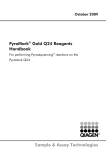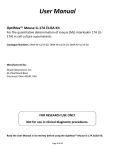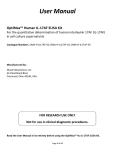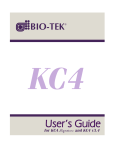Download View PDF file - Bio-Tek
Transcript
Tips for Improved Luminescence Performance Getting the Most of Out of Your BioTek Reader In order to achieve the best possible luminescence results from your BioTek microplate reader, several different parameters must be addressed. While there are an infinite number of possible combinations, addressing just a few key issues will greatly increase the likelihood of experimental success. In this technical note, we describe some of those issues and parameters. Introduction BioTek offers two reader series capable of measuring fluorescence: the Synergy HT and the FLx800. Depending on the model and type the end user will be able to perform various luminescent reactions. For example, only those readers configured with injectors have the capability to perform flash luminescence assays, while virtually all the luminescent capable readers can perform glow assays. Listed below are several different parameters, which may or may not apply to any one specific reader. Getting Started Plate Type: The type of plate used does matter. Opaque white plates have been shown to provide the best performance for luminescence assays, as they maximize the signal. Other plates can be used, such as white sided with clear bottom if necessary. Solid black plates will also work, but the signal will be significantly reduced. Quality plates should not allow any light leakage through the walls of the microplate. Filter Wheel Settings: In order to prevent any stray light from entering the optical path, an opaque plug is located in the excitation wheel in lieu of an excitation filter. Generally an open aperture on the emission filter wheel is used when performing luminescence measurements. However there are occasions where wavelength specificity is required for the luminescent emission. Filters can be used to eliminate much of the autofluorescence generated by white plates exposed to ambient light. However, note that the use of a filter instead of an empty position will result in an approximately 20% loss of signal. PMT Sensitivity Setting: The correct sensitivity setting is a critical parameter in obtaining the best luminescence results. It is important that the sensitivity setting be high enough to obtain a signal, yet still be within the linear range of the reader. There are several ways to arrive at the correct sensitivity setting. With glow assays, one can empirically determine the best setting using multiple filter sets, each with differing sensitivity settings. Alternatively, for many glow type luminescent assays, scaling to low well with a value of approximately 500 on a blank well will ensure that wells are above the X-axis. If this results in high wells returning an over-range message, then scale to high well (using 70,000-80,000 as the value) can subsequently be used to optimize the photomultiplier (PMT) sensitivity setting. With flash type assays one does not have the luxury of time and multiple readings are simply not possible. Trial runs with known samples with expected high levels of luminescence can be performed to determine a sensitivity BioTek Instruments, Inc., P.O. Box 998, Highland Park, Winooski, Vermont 05404-0998 USA COPYRIGHT © 2006 TEL: 888-451-5171 FAX: 802-655-7941 Outside the USA: 802-655-4740 E-mail: [email protected] www.biotek.com setting that is appropriate. Note that the PMT performs best around a setting of 150 and, as such, is a good value to start with. Read and Dispense Parameters: Most luminescent kit manufacturers recommend what if any reading and dispensing parameters their kit specifically requires. For example, Promega recommends a 2 second delay after dispensing 100 µl of Luciferin/Luciferase reagent, then a 10 second integration on each well when measuring ATP with the ENLITEN kit. Most glow type assays can be performed using a standard “endpoint” determination. However, detection of low levels can be enhanced with some sort of kinetic integration if the reader has that capability (e.g. Synergy HT with Injectors). Other luminescent compounds with a faster reaction time, such as aequorin, may require reading immediately after dispensing the trigger reagent. When using readers that do not have injectors for glow type luminescent reactions with low signal levels the signal to noise ratio may be improved by increasing the number of reads per well from the default of 10 to 50-100. The increase in read number provides better statistical averaging resulting in tighter CVs. Maintaining the Reader Flash type luminescent assays require the use of reagent injectors to provide reagents that initiate the reaction while the plate is in the reader. Use of these reagent delivery devices requires that the fluid path be maintained and free of contamination. Reader models that do not have reagent injectors generally do not need very much maintenance beyond the guidelines outlined in the user’s manual. Cleaning the System: In order for the best results to be achieved, it is absolutely necessary that the fluid path be maintained. If the reagent manufacturer specifies a cleaning procedure specific to their reagent, please follow it prior to running the daily cleaning procedure. The daily cleaning of the reagent injectors can be accomplished using deionized or distilled water. Using the “purge” feature to pump the solution back into the reagent bottle can save reagents. Immediately after purging of the reagents, use the prime function in the software to pump deionized water through the syringe and tubing. Using the “Prime” function, select 3000 µl and prime the system to several times. When switching between different assays, particularly when switching between a luciferase assay and an ATP assay, it is recommended that an Acid/Base cleaning procedure be used (see below). First rinse with deionized water using the “prime” function. Next prime the system with 0.1 N NaOH several times. Let the NaOH remain in the system for 10-15 minutes. Next, prime with 0.1 N HCl and leave this solution in the system for 10-15 minutes. Finally, wash the syringe with deionized water using the priming routine. ATP and Luciferase Assays: The quantitation of luciferase activity and ATP concentration are two of the most commonly performed luminescent assays. Interestingly enough, these two moieties are often measured using the same light emitting chemical reaction. Luciferase enzyme catalyzes the following reaction: ATP + d-Luciferin + O Luciferase 2 Oxyluciferin + AMP + Pyrophosphate + CO + Light (562 nm) 2 Depending on the limiting component, the intensity of light produced is proportional to its concentration. When luciferase enzyme is being quantitated, a mixture of ATP and luciferin substrate is injected to initiate the assay, while ATP assays require Luciferase enzyme and luciferin. Therefore, when switching between these two assays it is critical to insure that the reagent injectors and supply tubing are not contaminated with components from the other assay type. Cross contamination will lead to markedly higher background levels as a result of the luminescent reaction taking place in the tubing. Sterility: The measurement of ATP in solution is also prone to problems associated with contamination. The presence of ATP is often used as a means to detect cellular contamination. In order to prevent exogenous ATP it is important that aseptic technique be employed as much as possible. The use of gloves, sterile pipette tips and a HEPA filtered biosafety cabinet (if possible) when preparing the samples and performing the ATP assay is highly recommended. While the procurement of sterile white plates may be difficult or impossible, it is advised that the plate that is used is kept covered and free of contamination as much as possible. In addition, any buffers or solutions should be sterile and free of ATP. It is also recommended that the reader fluid path be chemically sterilized with 70% ethanol, followed by rinsing with sterile deionized water immediately prior to running the assay. Decontaminating the Reagent Injection System: The fluid path of the reagent injection system will need to be decontaminated periodically. It is recommended that the fluid path be treated with 0.5% sodium hypochlorite (bleach) for decontamination. Note that common household bleach is 5.25% sodium hypochlorite (NaClO) and requires a 1:10 dilution. After priming the reagent injector, keep the fluid lines filled for 15-20 minutes. Following decontamination, rinse the fluid lines several times with sterile deionized water to remove any residual amounts of sodium hypochlorite. Note that residual sodium hypochlorite can affect luminescence results. Promega Dual Luciferase Assay Reagents: One of the components of the Promega Dual Luciferase Assay kit, the Stop and Glo reagent, has an affinity to plastic materials. To avoid cross contamination when changing reagents it is recommended that the fluid lines first be rinsed with deionized or distilled water using the priming feature. Next prime the fluid lines with 70% ethanol and keep them filled for 30 minutes. The Stop and Glo reagent will partition to the 70% ethanol solution. After soaking, remove the 70% ethanol by priming several times with deionized or distilled water. Running the assays Plate Background Luminescence: The white plates commonly used for luminescence experiments will often fluoresce. These plates absorb energy from the ambient light in the room and then emit the energy as light during the luminescence measurement. This phenomenon can be a problem if the plates have been exposed to bright light for a particularly long period of time. Store unused plates in a dark environment and, when pipetting samples into the plate, do so in a reduced light in order to minimize plate autofluorescence. One can also “dark adapt” the plate by incubating it in the dark for approximately 10 minutes. The easiest way to accomplish this is to maintain it in the reader’s reading chamber prior to the initiation of reading. Follow the Manufacture’s Recommendations: While intuitively this is obvious, it is always a temptation to alter the amount of sample or decrease the amount of reagent. For many applications, using less reagent than suggested will provide adequate results but often at a cost, whether it be a decrease in the assay’s dynamic range or a decrease in sensitivity. Allow Reagents to Equilibrate to Temperature: Many reagents are stored frozen and it is particularly important to allow these reagents to equilibrate to room temperature prior to running the assay. Because many luminescent assays are integrated over a period of 10 seconds per well, it can take tens of minutes to run a plate. If the reagent has not properly equilibrated it will continue to do so while the plate is being read. The resultant variation in temperature can result in poor precision between replicates and an overall skewing of the data. Paul Held Ph.D. Rev. 4/13/04










